[This is an adaptation of the talk I gave for the 2016 Eleanor H. Boheim Lecture at Marquette University, sponsored by the Association of Marquette University Women on September 21, 2016.]
In August 2015, Georgetown University President John DeGioia sent an email to the university community announcing the rededication of Mulledy Hall.
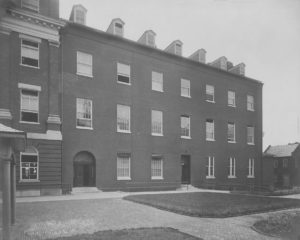
In that email he pointed out that the event offered an opportunity for reflection given Thomas Mulledy’s key role in the selling of the Maryland Province Jesuit’s enslaved population in 1838. The message was taken up by a columnist for The Hoya, one of the student newspapers, questioning why the University would honor this individual by leaving his name on a building and by September 2015 DeGioia had moved to form the “Working Group on Slavery, Memory, and Reconciliation,” and to remove Mulledy’s name, and that of William McSherry, (the two Jesuits with primary responsibility for executing the sale) from university buildings.
Since that point, the University’s efforts to find a path forward to address this history has been the subject of dozens of features and articles in the national press – the New York Times, the Washington Post, and many others.
At the beginning of September, President DeGioia presented the Working Group’s recommendations and announced the initial steps that the University would take to acknowledge and begin to repair the history of slaveholding and the implications of the fateful decision to sell nearly 300 men, women, and children to Louisiana to continue to live out their lives in perpetual, hereditary slavery. Included amongst those steps was the announcement that the descendants of the 1838 community would be granted “legacy” status for admissions at Georgetown. “In addition, our need-blind, meet-full-need commitments provide a framework in which to support students who are unable to meet the cost of attending Georgetown.â€
Since this event, there have been widespread conversations in the press on internet among historians, sociologists, activists, and other commenters about the sufficiency of these moves — the call for restorative justice and the debate about reparations for slavery is an active and lively one. In the end, almost every comment came down on the side of the GU’s gestures being just that, gestures: a welcome first step, but by no means sufficient to account for the long-term implications of this history. If you’ve read any of the press on these events, you’ll have a fairly good sense of the ongoing efforts to identify the descendants of the 1838 sale. Richard Cellini, a Hoya alumnus, launched a nonprofit to support the work by hiring a set of genealogists to help locate individuals, at this point upward of 2,500 people. The descendant community has been vocal in engaging with President DeGioia about what the university owes them going forward. The group GU272 has challenged the University to raise 1 billion dollars for a scholarship fund.
That the Jesuits who founded Georgetown in 1789 and staffed it during its early years owned hundreds of enslaved people who worked on their farms in Maryland might be news to the general public, but it was never a secret to historians, other Jesuits, or to the members of the Georgetown community who cared to investigate. The Archives of the Maryland Province of the Society of Jesus are housed in the Booth Family Center for Special Collections at Georgetown University Library, and have been open to research since the 1970s. As such, the documents surrounding these issues have been the subject of a good deal of historical research and writing.
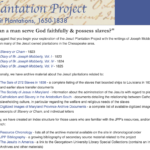
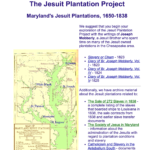
For me, the history of Jesuit slaveholding in Maryland and the questions surround it have been something that I have carried with me since I first read those documents in the mid-1990s as an undergraduate in the American Studies Department at GU (CAS ’97). The web was new in those years, and the program had undertaken a collaborative multi-year effort to digitize and publish the records of these events on the internet as the “Jesuit Plantation Project.” These were my first experiences with archival documents, and my training ground for working with digital methods to do history. The JPP is an example of Randy Bass’s notion that we can use digital tools to put “the novice in the archive,” an example of digital approaches facilitating authentic historical research. [This work has been redone and extended in a wonderful way by Adam Rothman and his students in the form of the Georgetown Slavery Archive.] I went on to graduate school, and eventually landed in the twentieth century — thinking about Catholics, race, reproduction, and justice in a somewhat different context, but Maryland Jesuits and their enslaved community stayed with me. And, no doubt, they stayed with the more than 50 other undergraduates who worked on the project in some way.
The Scholarship
The subject of Jesuit slaveholding has been an ongoing source of historical scholarship. The first significant treatment came in 1974 in a Master’s thesis from Peter Finn, SJ. Then in 1983, R. Emmett Curran, who was one of the faculty who launched the JPP, wrote an important chapter that provided the broad outlines of the story for the wider historical community (reprinted in a recent volume). He also addressed the events in his bicentennial history of the university. By the 1820s the six estates in Maryland were clearly in wretched condition and extreme fiscal distress. Rather than providing support for the Jesuit ministry in Maryland, the plantations were accumulating debt. Curran’s careful review of both the Maryland Province Archives and the Roman Archives of the Society of Jesus shows that the Jesuits wrestled with the issue of disposing of the slaves from 1814 until their actual sale in 1838. Curran’s picture of the Province is one wrought with strife, lines being drawn between the foreign-born and native-born priests, and between the generations. As the mission focused more on their educational mandate and the need for an urban ministry, younger native-born priests pushed for a sale of the slaves in the hopes of redirecting energy and resources away from agricultural activities. By 1838 those individuals achieved their goal by executing a massive sale of all 272 slaves to Louisiana. While Curran’s account addresses the intricate power structure of the Maryland Province and the subsequent complications in dealing with the issue of slaveholding, he does not address the reasoning of individual Jesuits that allowed them to participate in the actual master/slave relationship.[1]
In 2001, Thomas Murphy, SJ published his doctoral dissertation on the subject, which zeroed in on issues of motivation. In framing his work, Murphy claimed, “What is needed still is a reconstruction of the moral universe of these Jesuit–the ideological paradigms and experimental biases through which they analyzed the world they lived in and through which they approached the moral decisions they had to make.†He sites the following reasons: slaveholding was politically expedient in Maryland; the Jesuits were horrible financial managers of their farms (they were conflicted about money); and they has a theologically “justified,” race-based sense of paternalism toward (enslaved) African Americans. There are a number of things to take issue with in Murphy’s interpretation. He claims an exceptionalism for the Jesuits (“Jesuits always had their unique motives for slaveholding”) that I think is misplaced — or perhaps too celebratory: “the Jesuits always had their own reasons, springing from their status as professional Catholic men of God and participants in the Anglo-American culture that produced the United States.†Murphy’s claim that the Jesuits just don’t quite fit in colonial and early national Maryland is true, but I think that they are more like their neighbors than they seem. Were they more conflicted than their neighbors about the buying, owning, and selling of human beings? Maybe. In the end, did they make a decision primarily motivated by economics? Definitely. They were not interested in wealth for wealth’s sake, but to solidify the mission, they made a reprehensible decision.[2]
But to me, the thing that seems most off about Murphy’s work is the idea that we have done enough to understand slavery and that we need to focus on the motives of the enslavers. He claims, “Historiography has passed through several phases in evaluating slaveholding: championing it, measuring its efficiency, condemning it, reconstructing its narrative and using its example to shed light on pressing issues of today. Slaveholding has received enough attention that we are no longer shocked by its existence or its extent. It is timely, therefore, to look beyond the basic tale of Jesuit slaveholding and study the moral assumptions upon which its conduct and termination were based” (xxiii).
Indeed, slavery and slaveholding has generated mountains of historical scholarship–good and bad–in the last 100 years, but this community of enslaved people has received very little attention, which is a shame given the tremendous documentary resources. And, to some degree, I understand the reasons for that. Each of the major treatments of this particular history has been written by Jesuits about Jesuits. As such, there is an overwhelming concern with the reasons behind both the slaveholding and the decision to sell, rather than to manumit, the community. Moreover, these historians have been working from sources written by the Jesuits themselves, and those sources lend themselves most easily to inquiries and conclusions about their authors. But, the time has come to spend some time trying to learn about the enslaved community and its experiences with the Jesuits between 1717 and 1838.
This work, as the members of the Georgetown Working Group know in detail, is necessarily public history work — it requires a commitment to shared authority and co-creation, because it is deeply import for all of the communities who are tied up in this story. Many years ago Roy Rosenzweig and David Thelen did a large scale survey to discover how people who were not professional historians encountered and engaged with history in their everyday lives. Overwhelmingly the results pointed to the centrality of genealogy, family histories, and local stories — individual ties and individual lives. Acknowledging how important these encounters with history are, Rosenzweig expressed concern about the often-missing piece of larger social and structural analysis in those encounters, explaining that his concerns stemmed from a “belief that the past should be a vehicle for social justice.” I share Roy’s concern, but it is simply not possible to do this work without maintaining an eye on the larger picture of racism, on-going harm. This is a story both of individuals and the long-term institutional impact of historical events. The sale ensured stability for the university, a legacy advantage for students and alumni, like me, and a legacy of disadvantage for descendants of this enslaved community.
Slavery in Maryland
To situate Jesuit slaveholding in the larger context of colonial Maryland, it’s important to remember that Andrew White, SJ arrived with the first English colonists in 1634 to found St. Mary’s City. The first slaves in the colony also arrived on those ships. Though established a place where Catholics could take refuge in colonies, Catholics were never a majority of the population (10-12%).
In 1664, the Maryland colonial assembly passed the first law specifically codifying slavery as a constituting a lifelong term of servitude, prompted in part by the fact that enslaved people were claiming that their status as Christians entitled them to freedom under English law. Thus, the assembly codified perpetual slavery based on race, stipulating that slaves already in the colony or imported in the future would serve for life, that children of slaves would follow the status of their fathers. These regulations were revised and elaborated over and over through the end of the colonial period, exhibit increasing concern about lifetime service, miscegenation, and problems associated with run-aways.[3]
In the midst of this increasingly elaborate and repressive regime of perpetual, race-based servitude, the first mention of an enslaved person in the MPA occurs in 1717. Subsequently, the Jesuits began to acquire slave property, often as gifts from wealthy lay people in the area, such as James Carroll, who left the Jesuits a number of slaves in his will in 1729. (James Carroll was a generation older than Charles Carroll, signer of the Declaration of Independence and John Carroll the first Archbishop of Baltimore and the founder of Georgetown University). By 1765, the Jesuits owned 192 human beings.[4]
While the enslaved population in the United States grew significantly in the period between the Revolution and the Civil War, the same increase does not occur in Maryland. Rather, the enslave population hovers around 90,000 for decades, with the number peaking in the 1830s. In the years leading up to the 1838 sale, that population is concentrated in the counties where the Jesuit plantations are located.
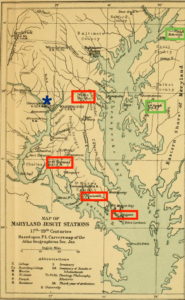
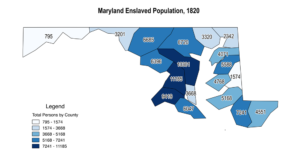
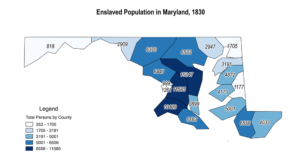
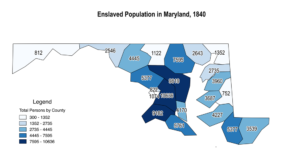
The Sale
In the 1820s, a cohort of American-born Jesuits rose to leadership at Georgetown and in the Maryland Province. These Roman-trained, Irish Americans–Thomas Mulledy, William McSherry, and James Ryder–led the university through the period of growth and stabilization that included the sale of the enslaved community. Mulledy served as University President from 1829-1838, while McSherry served Maryland Province Superior. The financial situation of the university and the plantations was precarious, and Mulledy and McSherry saw the sale as the only viable way to place the venture on firm footing, turning the Jesuit community fully toward the mission of education. Many, many of their fellow Jesuits disagreed.[5]
Mulledy and McSherry’s plan to sell lines up well with the larger narrative of the growth of the domestic slave trade in the first half of the Nineteenth Century. While no one would say that the Jesuits were primarily engaged in the market revolution but they were definitely planning to benefit from it and the increase in slavery generated wealth–the increasing value of their human property and the multiplier of natural increase through childbirth.
As Steven Deyle so skillfully reminds us, after the revolution, the Chesapeake is the primary source of the domestic slave trade. Having reviewed the various efforts to quantify the situation, Deyle affirms that between 1820-1860, at least 2 million American slaves were bought and sold, with two-thirds of those transactions in the course of local trade — not long-distance interstate trade, like that which was finally executed by the Jesuits. Furthermore, during that period, more than 875,000 enslaved people were sold from the Upper South to Lower South. Slave sale prices rose steadily from 1820 until the Panic of 1837, which sent them into a tailspin and decline into the mid-1840s. Then, they rose again in the 1850s. Prices generally followed that of cotton commodities.[6]
The Jesuit leadership finally fully debated the plan for a sale at the Maryland Province congregation (meeting) in 1835. Opinions were strongly conflicting among the ten delegates. After significant deliberation, Superior General Jan Roothaan finally agreed to the sale in 1836, but with a number of very specific conditions.[7] The conditions were as follows:
I. That thay [the enslaved] have the free exercise of the Catholic religion and the opportunity of practicing it.
Therefore,
a) They are not to be sold except to proprietors of plantations so that the purchasers may not separate them indiscriminately and sell them;b) it must be stipulated in the sale, that the negroes have the advantage of practicing their religion, and the assistance of a priest;
c) that husbands and wives be not at all separated, and children not from their parents, quantum fieri potest.
d) if a servant, male or female, have wife and husband on another plantation they are to be brought together, otherwise, they are no means to be sold to a distant place:
e) that those who cannot be sold or transported on account of old age or incurable diseases be provided for as justice and charity demands.
II. That the money received from the sale be in no way spent in making purchases, nor in paying of debts, but it must be invested as Capital which fructifies. The best way would perhaps be ground rents in the cities especially of Pennsylvania and New York – but in this you shall have to ask counsel both from Ours and externs.
Though Roothaan finally authorized the sale in October, 1836, the sale was delayed by the (May) Panic of 1837. After he became Province Superior in early 1838, Mulledy pushed through the stalled plans for the sale. In June, he struck a deal with Henry Johnson (former governor of Louisiana, whose nephew was a GU student) and Jesse Batey, both of whom were Louisiana businessmen. The buyers would receive 272 people for a price of $115,000, which works out to a price of between $410 and $425 per person, depending out how many individuals are included in the sale. Taking into account the demographic characteristics of this particular enslaved community the price makes more sense. This is a community with many young children (83 under 10), and many elderly (40 people over 50). With roughly 150 remaining young adults and adults, the calculated average price falls more in line with pricing trends.
Deyle reports that the price for a “prime†field hand in New Orleans is $500 in 1800 and that by the Civil War that price is up to over $1,800. That is a peak estimate for only the most fit, healthy, capable individuals. He suggests that the average price in New Orleans was half that for men and slightly less for women. So, given those parameters, an average price in New Orleans was around $250 in 1800 and $900 in 1860. Prices were lower in other areas. Prices rise through the 1820s, and peak in 1837, only to drop of significantly through the mid-1840s. In 1837, the New Orleans price for a “prime†field hand dropped from $1,300 to $700, which lines up fairly well with the deal that Mulledy struck with Johnson and Batey.[8]
The Community
The Maryland Province Archives contain five documents that are key to unlocking some of the central information about the enslaved community and their sale to New Orleans in 1838:
- 1838 Census
- Articles of Agreement (June 19, 1838)
- Bill of sale for 56 slaves from Thomas Mulledy to Henry Johnson, 1838
- Bill of sale for 64 slaves from Thomas Mulledy to Jesse Batey, 1838
- Bill of sale for 84 slaves from Thomas Mulledy to Henry Johnson, 1838
The census document appears to be the core list of individuals that serves as the reference point from which the other documents are created. It lists individuals, their relationships, their ages, their locations, and in some cases additional notes about their status or skills.
The other four documents are business communications that are filled with market and commodity exchange language. For example, the Articles of Agreement includes the provisions, “that the said negroes herein named shall be of different ages from that affixed to their names, and their value thereby impaired, or shall be unhealthy, or in any manner unsound, a fair deduction shall be made for such difference in age, or for such defects as shall lessen their value; and if the parties shall not agree as to the amount to be deducted, the question shall be submitted for decision to two arbitrators to be chosen by the parties.” Similarly, each of the bills of sale includes the key phrasing from Mulledy that seals the fate of the community: “I do warrant the said negroes to be slaves for life, and the right & title therof, I do warrant & defend unto him the said Henry Johnson, his heirs & assigns forever, free from the claim or claims of all persons whomsoever.” Significantly, none of these documents includes any language that relates to the conditions that Roothaan placed on the sale. There is no mention of family unification or of religious practice.
Reading these five documents closely allows us to build up some significant knowledge about the enslaved community. [My work product is available for review via Github.] Although the Articles of Agreement specify that 272 people are being sold, the 1838 census document lists 278 people. In cross-referencing that list with the lists in the business documents, we can see that the population is almost evenly split between men and women, and that the community is really spread through the lifecycle, with an overwhelming number of children and a significant cohort of elderly people.
Of the people in the census list, 155 of them are involved in some kind of family relationship (marriage, parent-child, grandparent, etc.). The author of the census document clearly indicates that there are 22 families, but careful reading suggests at least 41 families/marriages. Small children often go unnamed in the census, but triangulating with the other documents has allowed me to assign names and ages to many of them. Similarly, I have been able to identify and assign 24 surnames.[9]
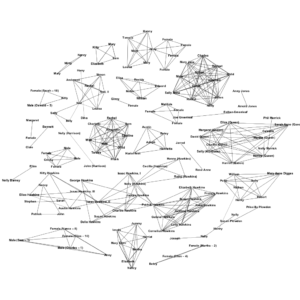
Furthermore, 21 people are listed as “married off,†suggesting that they are married to someone off the Jesuit plantations. In many cases, these individuals are also listed as heads of families. More importantly, all but two of them are listed in the bill of sale documents, meaning that regardless of their marital status, they were set to be shipped to New Orleans. Also, 11 people are listed as run-aways, but it is unclear when those individual notations were added to the census, before the business documents were draw up or after.
Of the identified families, the largest is the Hawkins group. Issac Hawkins, I, is the first name on the census list, and he is followed by 23 family members, spread across three generations. The entire family resided on the Whitemarsh Plantation. Isaac had a daughter, Nelly, and four sons, three of whom had families of their own. Nelly’s husband is not listed, so it seems likely he was not an enslaved person owned by the Jesuits. Also, Charles Hawkins is listed as a run-away.
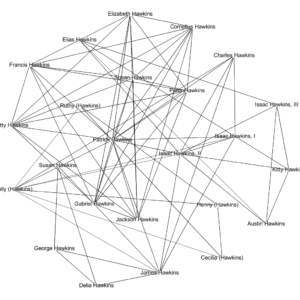

While the entire Hawkins family was slated for sale, the Articles of Agreement document includes an addendum listing over 50 people who were to be delivered to Johnson and Batey as soon as possible in the late summer of 1838, in exchange for an immediate payment of $25,000. This list corresponds to the individuals on the census who were assigned to “Ship 1.†(The rest of the group would be handed over later in the year, with the remaining funds paid out over a ten-year period.) James Hawkins and his family were designated to depart with that first group. A number of other large families were also on that list, including the entire Queen family.
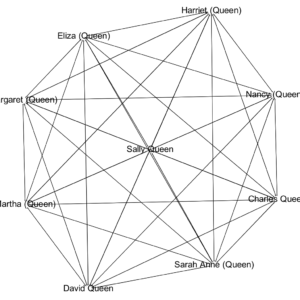
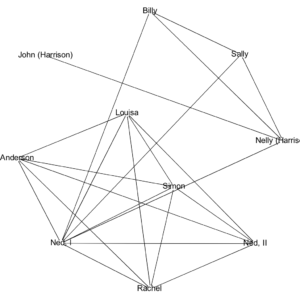
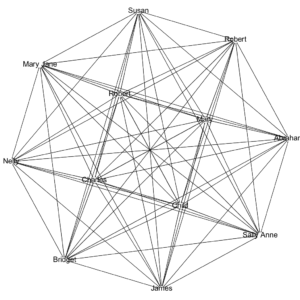
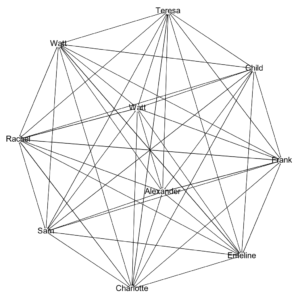
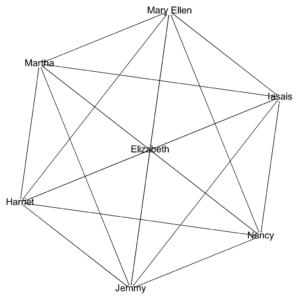
Interestingly, three members of Harriet’s family (Isaiah, Nancy, and Martha) are listed as being run-aways, so it’s possible that they did not end up on that first ship.
Similarly, the departures of the other individuals is still somewhat hard to determine. The census lists 34 people as being assigned to the second ship, and they clearly correspond to the manifest of the Katherine Jackson. But, that manifest lists 130 people, who might map to others in the census. Fifty-six people were assigned to the third ship on the census, leaving 135 people unassigned.
Thus, some work with these five documents is revealing, but it represents only the first steps in trying to recover a more full sense of this particular enslaved community and their lives with their Jesuit slaveholders.
NOTES
[1] R. Emmett Curran, “‘Splendid Poverty’: Jesuit Slaveholding in Maryland, 1805-1838,†in Catholics in the Old South: Essays on Church and Culture, edited by Jon L. Wakelyn and Randall M. Miller, 125–46. (Mercer University Press, 1999); —–, The Bicentennial History of Georgetown University: From Academy to University 1789-1889 (Georgetown University Press, 1993).
[2] Thomas Murphy, Jesuit Slaveholding in Maryland, 1717-1838, Studies in African American History and Culture (New York: Routledge, 2001), xv-xxiii.
[3] Ross M. Kimmel, “Blacks Before the Law in Colonial Maryland” MSA (January 24, 1974), Chapter III. Available: http://msa.maryland.gov/msa/speccol/sc5300/sc5348/html/chap3.html. Based on: Kimmel, Ross M. “The Negro before the Law in Seventeenth Century Maryland.†(MS, University of Maryland, 1971).
[5] Curran, Bicentennial, 107-112.
[6] Steven Deyle, Carry Me Back: The Domestic Slave Trade in American Life (New York: Oxford University Press, 2006).
[7] Superior General Jan Roothaan to McSherry, October 27, 1836, MPA F-3-A[2]-F5-E, GULSC.
[9] Surnames: Hawkins; Queen; Plowden; Harris; Brown; Harrison; Greenleaf; Merrick; Jones; Digges; Eagline; Dorsey; Campbell; Barney; Walton; Sweetum; Johnson; Lewis; Riley; Blair; Coyle; Cush; Hill.
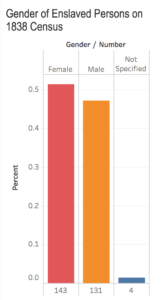
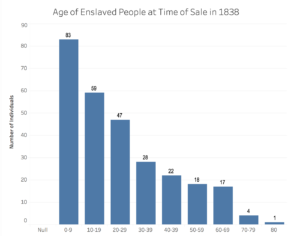
[…] Read full post here. […]
Thank you for continuing to track the people enslaved by the Jesuits at Georgetown. I became aware of the story in 2014 when I came across a tombstone in my town(Hammond, La.) that belonged to a man enslaved by Gov.Henry Johnson, and listed his place of birth as Washington DC. I believe he and his family may have been enslaved by the Jesuits, but were part of an earlier 1835 sale where 11 people from St. Inigoes and 14 from Whitemarsh were sold to Gov. Johnson and a man named Jamison. Johnson paid off the mortgage promptly which surely made the 1838 sale to Johnson more attractive.The original JPP was an amazing resource when I began my research without having access to the original documents. The spread sheets that separated the people by plantation, and ship was incredibly helpful. Around the time the students at Georgetown started protesting the JPP disappeared. Luckily I had printed much of the information, but I was really disappointed that it was unavailable. I wrote to the university, and explained how access to the information was vital to people especially descendants doing research. Luckily the New archive is really nice, but I still miss the old JPP, and I was excited to see some of the JPP information (1 page for some reason) had been included. Just wanted to let you know how much your work helped me. I feel really sorry for people who have to sort through all the recent media information before they can get down to the real facts.
Thanks so much for your note, Melanie. I hope that you’ll follow the project as it develops and that the work will be useful to you.
Melanie
I would love to see the original JPP. Has it been located?
One of my relatives was part of 272, I am seeking info on others who were clearly associated with the Hesuits, in fact, in the Letters was great grandfather was called a “loyal retainer†by the Jesuits.
I am focusing on all farms but no luck yet. The document you refer to may be of enormous help-my missing puzzle piece.
Appreciate any help
Genevagraceroots@gmail
The “original” JPP no longer exists, but most of it is viewable at the Internet Archive: https://web.archive.org/web/19970607230446/http://www.georgetown.edu/departments/amer_studies/coverjpp.html. All of the materials that were there are now available at the Georgetown Slavery Archive.